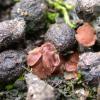
30-12-2025 09:04
Hello.A Pyrenomycete sprouting sparsely but very d

29-12-2025 17:44
Isabelle CharissouBonjour,J'aimerais savoir si d'autres personnes au

12-11-2021 00:03
Lepista ZacariasHi everybody,A week ago in my fiels trip I noticed

29-12-2025 17:12
 Bernard CLESSE
Bernard CLESSE
Bonjour à toutes et tous,Pourriez-vous m'aider à

29-12-2025 17:01
Gernot FriebesHi,I'm looking for help with this hyphomycete with

29-12-2025 08:30
Hello.A tiny ascomycete sprouting under Juniperus

29-12-2025 10:15
Hulda Caroline HolteHello, I found and collected this propoloid ascom

29-12-2025 09:38
Oskari VirtanenHi,could anyone help me identify this, I suspect P
 salut a tous,
salut a tous,in case of an article about pseudombrophila bulbifera, i'm in search of informations concerning ecology and distribution. has anybody made collections of this rare taxa, one of only two pseudombrophila-species with globose spores?
if someone has the diagnose of boudiers ascophanus dentatus (Bull. Soc. Mycol. France 13) i would be very thankful!!
Cordialement
Dirk

schöner Fund. Hast du die Pseudombrophila Arbeit von van Brummelen?
Die Arbeit von Boudier findest du hier:
Du zweifelst wohl an deiner Bestimmung? Die beiden Arten unterscheiden
sich nur durch die Sporengröße (über 10 oder unter 10 µm für denutata) und Ps. bulbifera
soll ein Sclerotium habe, was ich bei meinen Fund aber auch nicht so recht
finden konnte.
Gruß Peter

Moyne G. 2008. Pseudombrophila bulbifera (E.J. Durand) Brumm. Un champignon coprophile peu commun. Bulletin mycologique et botanique Dauphiné-Savoie, 191, p. 45-49.

On article about coprophious mushrooms I'm always interested. One can not unfortunately have any magazines. The love of money is not enough there. ;-)
Best regards Peter
PS: Mistake on my part. I meant Nicolas. Nobody is perfect. ;-)
Rene your proposal is not bad either, which has everything you as a PDF, you can take in the computer.
Thank you Peter
Je vous adresse, en privé, à cause du poids, un scan de la publication de Brummelen, répondant à votre demande.
Je signale toutefois qu'il y a, dans ce genre, et contrairement à ce que vous avez indiqué, deux espèces qui possèdent des ascospores sphériques. la deuxième étant P. dentata, sur excréments de lapin !!
René


